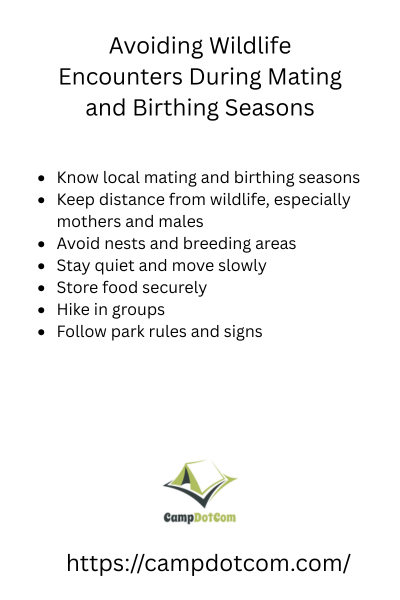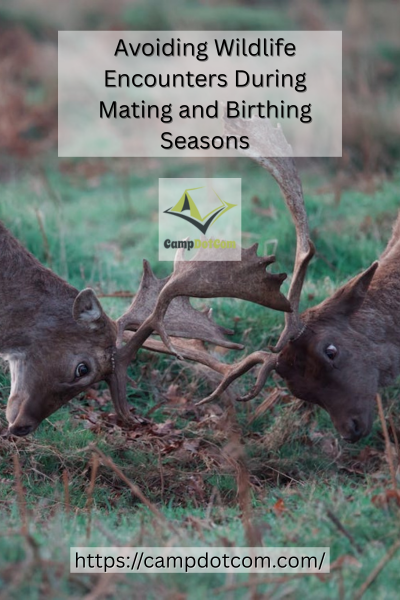Avoiding wildlife encounters during mating and birthing seasons is something many people don’t think about until it’s too late. I learned that lesson one spring afternoon when a very protective goose decided my jogging route was way too close to her nest. Let’s just say, I’ve never run so fast in my life — and I wasn’t even wearing running shoes.
Wild animals can be fascinating to watch, but during these critical times of the year, their tolerance for humans drops to nearly zero. Understanding why and knowing what to do can save you from a scary (and sometimes dangerous) experience.
Read More About Avoiding Wildlife Encounters During Mating and Birthing Seasons

Why Mating and Birthing Seasons Make Wildlife More Aggressive
Here’s the thing, animals aren’t being mean when they charge, hiss, or block your path. During mating season, hormones are running high, and males might be on edge, ready to fight off any competition. During the birthing season, mothers become fiercely protective of their young.
As an Amazon Associate, I earn from qualifying purchases. Some of the links in this article are affiliate links. This means that, at zero cost to you, I will earn an affiliate commission if you click through the link and finalize a purchase.
I once accidentally walked too close to a deer and her fawn while hiking. She didn’t attack, but the way she stomped her hooves made it clear she wasn’t inviting me for tea. If I hadn’t backed away slowly, that story might have ended very differently.
More Things to Know About Avoiding Wildlife Encounters During Mating and Birthing Seasons

Signs You’re Too Close
When avoiding wildlife encounters during mating and birthing seasons, knowing the warning signs is half the battle. Some animals will give you very obvious cues:
– Ears pinned back, growling, or hissing (think big cats or raccoons)
– Wing flapping or loud vocal warnings (birds like geese and swans)
– Stomping, pawing the ground, or mock charges (deer, elk, moose)
If you see these behaviors, it’s time to create some space — fast, but not in a panicked sprint.
How to Stay Safe Outdoors
Whether you’re hiking, camping, or just walking your dog, here are some practical tips for avoiding wildlife encounters during mating and birthing seasons:
1. Know the Calendar
Different species have different timelines. Bears, for example, may give birth in winter but emerge with cubs in spring. Elk and deer often have fawns in late spring or early summer. A quick online search for your area’s wildlife activity can help you plan.
2. Keep Your Distance
That “perfect” photo isn’t worth the risk. If you think you’re far enough away, take two more steps back. I once saw a tourist get too close to a moose for a selfie — spoiler alert: the moose won.
3. Stay on Trails
Animals choose nesting or birthing spots away from well-traveled paths. Sticking to established trails reduces the chance of you surprising them.
4. Control Pets
Your dog might be friendly, but wildlife sees them as a threat. Keep pets leashed, and avoid areas with recent animal sightings.
5. Make Your Presence Known
A little noise goes a long way. Talk, clap, or use a hiking bell so animals aren’t startled by your sudden appearance.
What to Do If You Encounter an Animal
Despite your best efforts, sometimes you’ll still cross paths with wildlife. The key is to stay calm.
If you’re too close to a protective mother, back away slowly without turning your back. Avoid making direct eye contact with predators, as it can be seen as a challenge. For large herbivores like moose or bison, put something solid like a tree, rock, or even your car between you and them.
And if a bird starts dive-bombing you, yes it happens, raise your arm or hat above your head. They will usually target the highest point, and you can keep walking to get out of their territory.
Respect Goes a Long Way
Remember, we’re the visitors in their home. Avoiding wildlife encounters during mating and birthing seasons isn’t just about your safety, it’s also about reducing stress for the animals. When we give them space, they can focus on what nature intended, raising their young and keeping their species thriving.
I’ll admit, I still get a thrill when I spot a wild animal in the distance. There’s something magical about knowing we share the same world. But I’m also more aware now because that goose taught me well. Sometimes the best wildlife encounter is the one that doesn’t happen at all.
Mastering Wildlife Awareness for Safer Outdoor Adventures
Staying aware, keeping your distance, and respecting animal behavior can make your outdoor adventures both safe and memorable. You’ll still have great stories to tell, just without the part where you had to outrun an angry goose.
So next time you’re out exploring, keep your eyes open, your noise level just high enough, and your camera lens zoomed in rather than your feet stepping closer. Nature will thank you for it.
